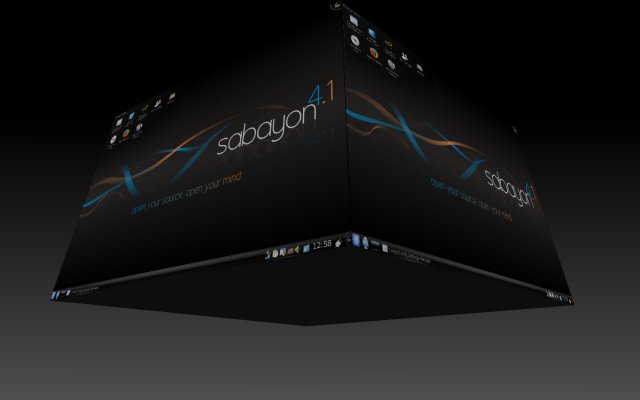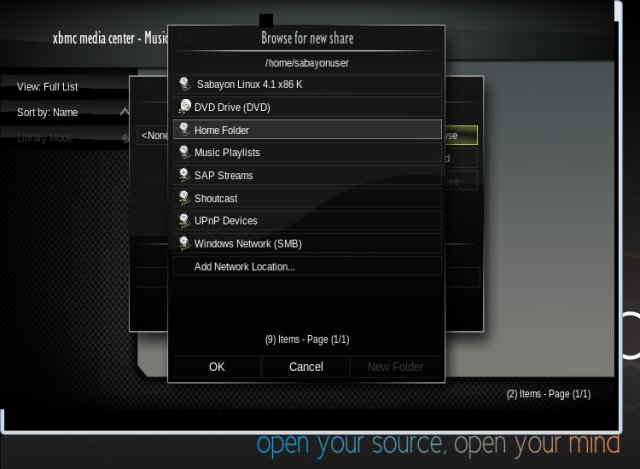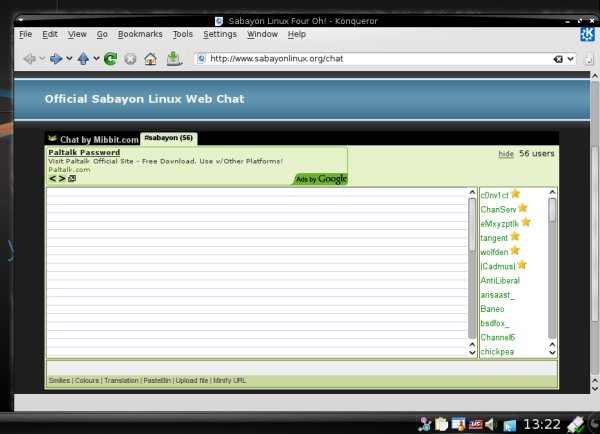Updated: May 7, 2009
Sabayon was probably the first Linux that offered 3D gadgets in the live session out of the box, no special configurations on behalf of the user required. It is also probably the first Linux that demanded more than 10GB of hard disk space as a requirement for the installation. Sabayon is also based on Gentoo, which makes for yet another wonder.

In September 2008, I tried Sabayon for the first time - and liked it very much. It was a revolution. The live session was phenomenal, practically with everything the user could hope for. So good, in fact, that you might ask yourselves what next? How do you up the ante? How do you turn great into greater?
Time to check Sabayon 4.1 then!
Like its predecessors, the 3.x generation, the new Sabayon 4 (and 4.1 just released) breaks a whole new book of rules when it comes to what it demands - and what it gives back.
On one hand, there are the hardware requirements. Huge! Sabayon requires a minimum of 10GB for a hard disk installation, with 32GB recommended. This is more than Vista and Windows 7 combined! Then, you ought to have at least 512MB RAM to get it going, while most Linux distros purr along nicely with that much (little).
However, in return, Sabayon promises all of the following and then some: KDE 4.2, smaller footprint, faster boot times, EXT4 filesystem, better support for other Linux installs, new Xorg, Compiz and Network Manager, World of Goo game demo, Media Center. Holy banana, that's quite a list, isn't it? Can it actually do all that?
Live session - Take an inhalation first
I booted Sabayon 4.1 KDE on my T42 first. The boot menu is slick, polished and expensive. It has quite a few entries, including music, which seemed odd, and MCE, which we will talk about later on. I selected the third option (3D).

Then, something strange happened. At first I thought my computer was dying as it started to make funny, SoundBlaster style noises, which slowly turned into music. Music? Yup, Sabayon was playing a song for me while it sliced away the percents as it progressed into the desktop. So, that explains the music thingie in GRUB.
This was another first for me. The choice of the music title is a bit curious, a somewhat hard-rock song called Rock 'n' Roll Hall of Fame, which may not suit everyone, but definitely embodies the spirit of this crazy, mammoth distro.
The boot time was long. The song actually completed before desktop came up. In fact, it never came up. The screen blinked and turned black. I thought Sabayon had not come up, but it had. I was able to switch consoles using Ctrl + Alt + Function keys. I was logged in runlevel 3. When I switched to runlevel 5 manually, nothing happened. Running startx did launch GUI, but it was just a collection of basic xterms, not the glorious KDE that I expected. Okay ... I tried two more times. No luck. T42 was out of the game. Sabayon did not like my ATI card.
Next, T61. This time, it was a T61 other than my standard scapegoat, which was undergoing repairs. Technical issues aside, I had a T61 similar to my own, only with an Intel card instead of Nvidia. Other hardware bits were identical. This time, after about 3 minutes of boot time, a beautiful, streamlined desktop came up.

As promised, the theme and the skin used were really elegant. You must admit that Italians have a knack for style. Their cars - and Linux distros - look rather sexy.
Wireless
Not everything can be perfect. I had no wireless ... the same problem with this series of laptops that has haunted me for quite long. The network adapter was recognized, but I could not get it to run. Trying to bring it up with ifconfig threw an Input/Output error.

I was forced to connect a cable and used the wired connection. Oh, by the way, the notification popups are designed with utter elegance, even though the network manager icon is a bit confusing: the white adapter-like icon in the system area on the far right has nothing to do with power, it's the network manager.
Sound
To make things even more complicated, another error came up. A few minutes into the live session, the distro complained about the sound device and reverted to Pulse Audio, which left me without any sound at all.
Bluetooth
This was gone, too. It worked the last time, with Sabayon 3.4, albeit on a different machine. Hardware detection had worsened, it seemed. It could be a bad stroke of luck and the choice of hardware components, but these many issues at once were unfortunate. No distro has given me so much woe yet.
But not all was lost. Far from it. Ignoring the sound issues and the fact I was using my laptop in the Dark Age mode (wired connection), I started exploring - and with every step I took, things just got better. Maybe that's the trick, start low and keep the goodies for the end.
Compiz
No bad surprises here. Compiz was working, out of the box.
![]()

Web camera
This one worked without any problems, too. I started the Kopete instant messaging program and opened its settings menu. When I clicked on Video, the web camera turned on and started taking pictures of me pretty features.

Just half a year ago, I have conducted a test to see how many Linux distributions supported web camera devices out of the box. The result was 3 out of 9. Since, I have tested a large number of distributions and most do, a clear sign of progress. Sabayon is another candidate on the growing list.
Multimedia
Compared to version 3.5, things have improved. The last time, Flash did not work and I had to install it manually. Not this time. The Flash Player was installed and working out of the box.
Flash
In fact, the Flash support is evident even before you go any further than the Sabayon website page that opens by default when you launch Firefox. One of the promotional elements on the site is an embedded Youtube Sabayon demo.

But for those skeptical, I went to Youtube and launched the legendary Crockett's Theme:

MP3 playback
No problems either. I could not hear the actual audio, so I can't vouchsafe for the quality of sound, but VLC player, the default music player installed on Sabayon 4.1, rolled the tune without any issues.

Windows Video
This one worked well too (in Dragon):

Applications
Sabayon 4.1 has an interesting assortment of programs, well balanced across a range of categories. You get the standard array of K-programs, plus some extras, like Amarok, VLC, Dragon, OpenOffice, Firefox of course, and others. GIMP is missing, though. You also get GwenView, a lightweight yet powerful image viewer akin to phenomenal IrfanView, a Windows utility with a Linux heart.

There's also the system utility called Sweeper, which we reviewed in the PC-BSD article. Then, you also have GParted to work on your disks. And if you've read my extensive tutorial, you should love this excellent program.

Then, I noticed this thing called XBMC ... At first, I thought it was just another program in a series. However, it turns out to be a whole ...
Media Center!!!
Sabayon 4.1 comes with a complete, preconfigured, superb-looking multimedia hub! You read it right! A complete solution, which leaves any other similar products you have seen or tried three lightyears behind! It sounds incredible, but it's true.
You get the incredible, beautiful XBMC 8.10 installed and ready for use. You don't have to leave the comfort of your desktop. Just fire up the Media Center and enjoy. And when you're done, go back to your usual stuff. Here's a small gallery for this phenomenal utility:





Just to show you how mighty XBMC is, I decided to grab a number of songs from a Windows NTFS share. So I started the setup for a new share and selected Windows Network (SMB).

Added the new music source and called it Windows:


And then fired up Chariots of Fire, leaned back and relaxed:

Simply stunning. The Sabayon boot menu includes entries for the XBMC, so you can skip the desktop use and boot right into the Media Center.
In general, this is somewhat akin to MythTV, only far easier to setup and use. For those interested, XBMC is available for Linux, Windows, Mac, and even Xbox. The software supports a staggering array of audio and video formats and many languages, it is network capable, skinnable, and extensible with plugins, some of which include train timetables, email, Internet radio station browsers, IRC, P2P, and more. We will have a separate article for XBMC. And we'll get back to MythTV, as well!
Other stuff
After this mind-blowing surprise, one can almost forget the issues that arose at the beginning of the session. If I were a bit skeptical about whether Sabayon can deliver, I had my answer now. It sure could. And it did in the most unusual way.
It left me hanging in the dry with rather basic stuff like hardware support and then sweetened its poison into my heart with radical, unique features that you don't get to see every day. It was a pure masochistic delight akin to none I've seen so far.
But Sabayon 4.1 was definitely worth the installation. I had to see how well it would fare there and whether the updates system has improved since version 3.5.
But first, a few more things ...
Games!
Just when you think Sabayon can't squeeze any more juice from your quivering soul, you get another shattering blow to your senses. Sabayon always prided itself in being user-friendly, and this means tons of multimedia and games. Version 4.1 does not disappoint here. As a teaser, it comes with the demo for World of Goo, a popular, multi-platform physics game.



Later, after the installation, we'll take a look at what other goodies can be found in the repositories.
Finally, other other stuff ...
NTFS sharing
Well, since XBMC worked, there was no reason why NTFS sharing outside the application would not work. Indeed, there were no issues.

Looks
The beauty of the distro is clearly visible in every little bit. Even when you do something as peculiar as inserting a USB drive and opening the Dolphin file manager, you're welcomed by artful details that make an already aesthetically pleasing experience all the more enjoyable. Notice the USB drive icon, for instance.

Live chat assistance!
Another mind-blowing trick. If you taken a look at the plasma screen on your desktop, you may have noticed an icon that says Get Live Help.
![]()
If you click on it, you'll be taken into a chat room, hosted on the Sabayon site, where you can chat with other users about problems you have. Truly commendable - original and yet obvious, when you think about it. I hope other distros will follow suit.


Now, finally, there were no more tricks left. I was tremendously pleased, having forgotten all about my problems earlier. Sabayon has lured me into its grasp. I felt like a man arguing with a very, very good looking girl who has just rammed her car into the back of yours, and although every instinct inside you begged that you scream at her, you can't help smile dumbly. Anyhow ...
Installation
The last time I tried Sabayon, the installation was a bit confusing, mainly the partitioning. Sabayon 3.4 used LVM by default, turning a simple thing into a noobie nightmare. If you have read my GParted tutorial, thing might not be as dreadful as they seemed back then, but still the choice was not the best one. Let's see what version 4.1 brings here.

I must say I'm pleased. The development team must have listened to my woes and simplified the installation menu. The beautiful theme is omitted, leaving the users with a plain, easy-to-follow wizard with as little visual distractions as possible.
Like the last time, you have individual steps to choose the installation type, from full-blown KDE via XBMC to more lightweight solutions, the software packages that you wish to include and the services you want to run on startup. Very nice.



Partitioning
This step has improved too. You're back to basic, with EXT4 filesystem selected by default. I created a rather simple layout with EXT4 / and /home, and 1GB swap.

After that, I configured the hostname and users and started the installation.

Sabayon was rather slow in this regard. It took more than an hour to install, then again, it takes 3-4 times more space that your average Linux installation, so the numbers add up.
After the installation
The installation ended approx. 6.5GB, less than the dreadful minimum requirement. In this regard, Sabayon is similar to Windows 7 when it comes to how much Vitamin D it needs to work. The most important thing for me was to check the Package Manager, a sore point in the last release.
Package management
I'm pleased to say things have improved, again! The Spritz Package Manager is not the fastest, but it is well laid out and simple to use. The first thing you'll want to do is refresh (update) the repository index and then check out for updates or new software.


Then, you can search for software and install it:


Or check for updates:

Good. No need to play with the complicated Gentoo emerge and whatnot.
Games
We've talked about games earlier. Quite a handsome selection can be found in the official repository:

Wow, that would be all ... I'm spent.
Conclusion
Sabayon 4.1 is an incredible, unique distro. The fact it is Gentoo underneath defies common sense. Gentoo usually takes a pint of virgin blood to get going.
Hardware issues were a big one. Old bugs were resolved, quite gracefully, to be replaced with new ones. If you get Sabayon cooperating with your hardware, you'll be tremendously pleased and never look back. But for those who encounter problems, these could be true showstoppers. Wireless is a must. And so it getting the distro to boot in the first place.
I have tested many distributions over the past year and so far, Sabayon has had the worst hardware compatibility among the big players. This has to be solved. It's a must. I hope the developers take heed.
But then, just when you think about giving up, you're drowned in a sea of goodies. You simply don't know where it hit you. You get Compiz out of the box and an almost perfect KDE 4.2 desktop, which is quite hard to achieve ... And you have a complete Media Center!
And then, there's the live chat, which really makes the difference, web camera support, NTFS sharing, games, multimedia, all working out of the box. You also get the expected Gentoo stability. It's very difficult to dislike Sabayon.
All combined, Sabayon is a phenomenal distribution, provided you get it to like your machine. Once past this stage, it will do well, even if it's costly when it comes to RAM and hard disk space. A few quirks here and there can be lived without, like the startup music, for instance. But the return of investment is tremendous. You will be hard-pressed to find a distribution that give you so many new and unique features.
My final word is: try Sabayon, it can't hurt. If it does not work for you, think of it as a missed first date; you won't really know what might have turned out. If it does, you'll fall madly in love.
Cheers.